Intelligent Transportation System Solution
Table of Contents
Introduction:
Intelligent Transportation System (ITS) is a new generation of high technology using modern information and communication technology, network sensing technology, cloud and mobile computing technology, intelligent terminal and vehicle-road cooperation technology, intelligent space-time network control, etc. It is efficiently applied to the whole traffic management system to achieve more comprehensive perception, deeper integration, and information sharing among people, vehicles, and roads. We implement dynamic supervision and networked intelligent traffic flow control to establish a harmonious, safe, efficient, and energy-saving traffic environment and realize an integrated intelligent traffic management system without traffic jams and collisions.
Intelligent Transportation System (ITS) is a new type of transportation system that improves the operational efficiency of the transportation system, reduces traffic accidents, eases traffic congestion, reduces environmental pollution, and is information-based, intelligent, social, and humanized. Its ultimate goal is to establish a real-time, accurate, and efficient transportation management system.
The Pain Points Analysis of Intelligent Transportation Communication.
- The scale of the communication network is large, it the difficulty to integrate communication systems and the lack of professional communication solutions.
- Access layer communication products are widely distributed, multi-point communication and outdoor environment are very different, and access network stability requirements are higher.
- Many subsystems, flexible and variable networking, complex types of access equipment, and difficult and challenging late operation and maintenance.
- Redundant communication needs, there is a demand for all kinds of ring network networking applications. The system requires strong fault tolerance, fast self-healing speed, and smoother transmission, and the traditional communication solutions need to be optimized and upgraded.
The City Intelligent Transportation Communication Solution.
Intelligent transportation is a service system based on modern electronic information technology-oriented transportation. It collects, monitors, and analyzes road traffic information and traffic-related service information and realizes reasonable control and decision-making. A typical intelligent transportation system contains a signal control system, electronic police system, speed detection system, closed-circuit television monitoring system, traffic event detection system, traffic guidance system, power supply, lightning protection system, GPS vehicle positioning system, traffic communication system, and other subsystems. The traffic communication system is the most critical support layer of the intelligent transportation system, providing an effective, fast and accurate information transmission channel for public security traffic command and dispatch.
HoweVision Technology is committed to building a real-time, reliable, and robust intelligent network for intelligent traffic information and extensive data collection. We have developed a variety of highly reliable, industrial-grade, and brilliant communication products to meet the communication needs of the transportation industry. We provide professional communication solutions to guarantee the high-speed passage of massive information and comprehensively open the door of intelligent communication.
Communication System Network Solutions
The traffic communication system can be divided into core, convergence, and access. The network hierarchy can clearly define the interface and function of each network layer, realize good planning of the network, and make full use of equipment and link resources.
- Core layer: Located at the uppermost layer of the network, it is the data exchange hub of the communication system. Completing the data exchange between the front-end devices of each subsystem and the servers of each system platform in the center and realizing the functions such as docking with the public security network and other private networks.
- Convergence layer: Located in the middle layer of the network, it is the main body of the communication system and is responsible for the convergence and transmission of data of each subsystem. It provides high-speed, low-latency, and high-reliability transmission channels for services.
- Access layer: located in the lower layer of the network to achieve the end of the communication system access. As the front-end equipment interface form of intelligent transportation systems, transmission needs vary, the installation environment is complex, corresponding to different markets, and the network access is also flexible and diverse ways to achieve.
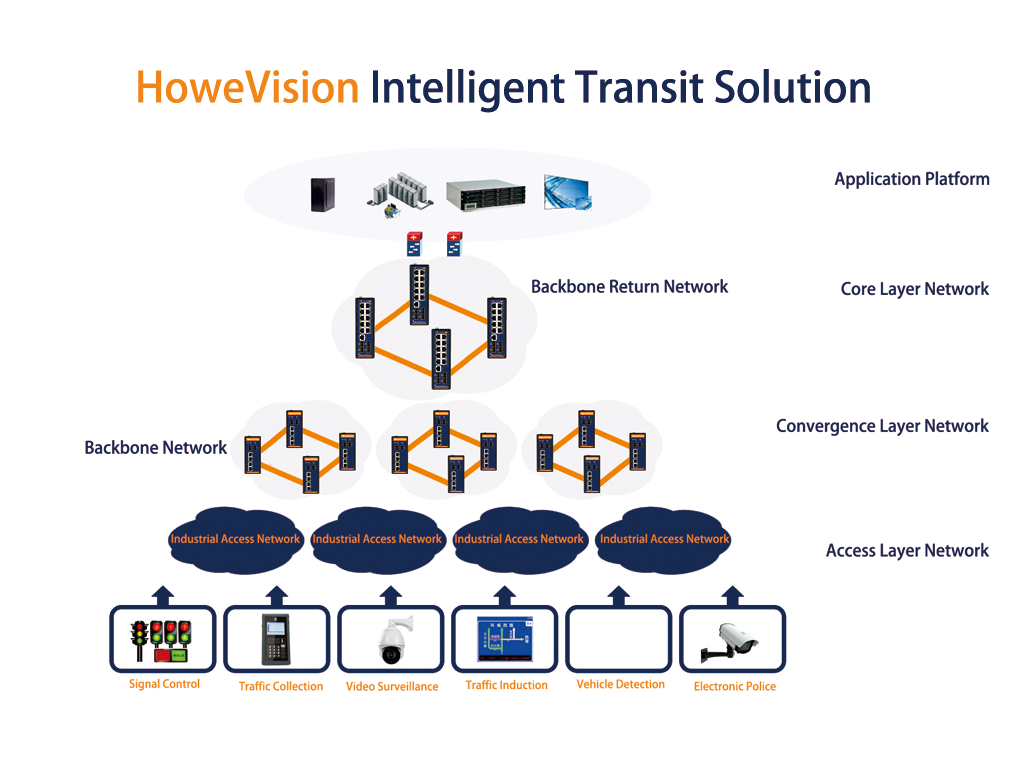
The Core Layer Network Solution
The intelligent transportation system in the command center installs the core switch to achieve a layer3 core exchange of data. The command center network is formed by the core switch and the command center server, the center access switch, etc.
The platform layer of the intelligent transportation system is built by the intelligent transportation operation and maintenance platform, the video integrated management platform, picture storage system, NAS storage system, extensive screen display system, central control subsystem, and other equipment. The primary devices are various application servers (database server, platform application server, operation, maintenance management system server, streaming media storage and forwarding server, monitoring center management server, etc.) and storage devices.
Each application server is assigned two IP addresses of different network segments by dual NICs connected to the central access switch in the main server room. VLAN division is performed at the central access switch to divide the dual NICs into different virtual LANs. The servers in the command hall adopt the same access mode to ensure reliable transmission of traffic management data through network redundancy. The dual uplinks of the central access switch connect to the primary and backup core switches, respectively. The main and backup redundant links ensure reliable data transmission.
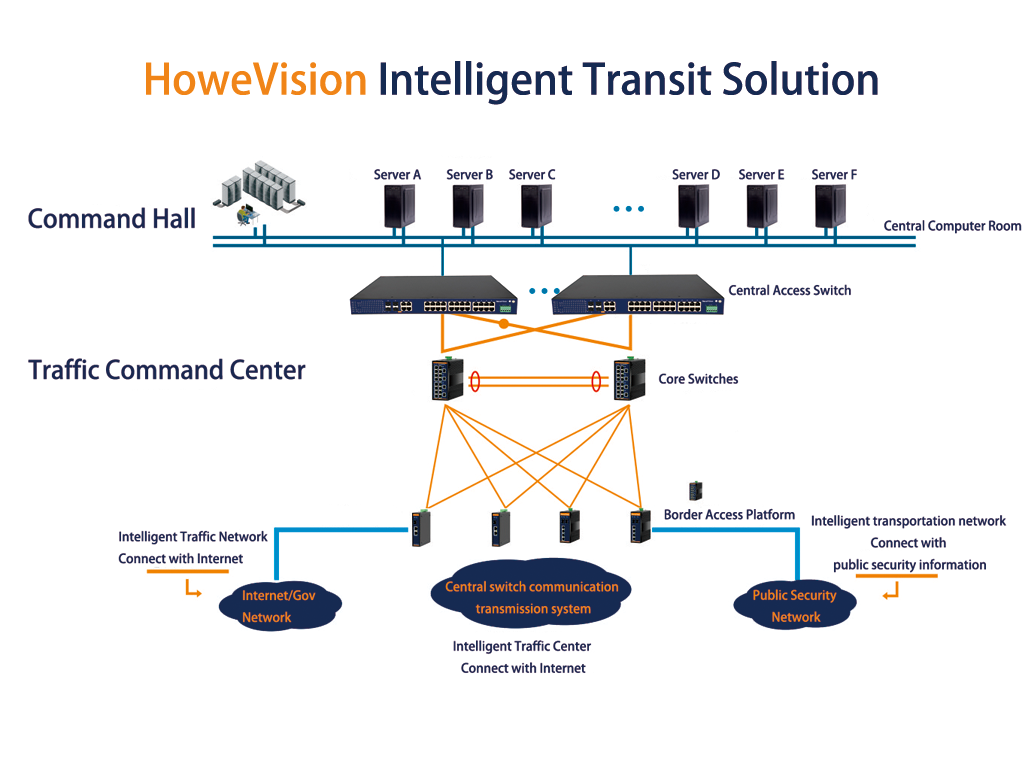
The intelligent traffic network mainly transmits video images and traffic management data. The public security information and communication network (public security network) is primarily used to transmit necessary data such as public security management business information. A security access platform is used to isolate the two networks, which support the shared transmission of data from the intelligent traffic network, digital video images, and the public security network.
When the intelligent traffic network needs to share information with the outside world, release information, and provide traffic services. It needs to interact with other networks, such as the Internet, government networks, banking networks, digital city management networks, urban emergency center networks, etc. A secure access platform is also used to isolate the two networks, which support the shared transmission of data from the dedicated, intelligent transportation network, digital video images, and interconnected networks of outside units.
The data from the outer field is transmitted back to the core switch through the transmission network of the communication system. The second layer between the external field and the central subsystem is isolated, and the interaction between data is realized through the core switch.
As the core switch is the critical forwarding node of the whole network, the single-core network architecture cannot resist the risk of failure. Therefore, the core layer network generally adopts dual-core or multi-core redundant backup network architecture. There are two ways to implement redundant backup: traditional MSTP+VRRP technology and network virtualization technology.
MSTP+VRRP
Two core switches are used as a fault-tolerant backup for each other, and a redundant design of key modules (dual power supply redundancy, etc.) is adopted in the core switches. The core, central convergence, and central access layers are connected with double links to form a loop architecture. VRRP and MSTP protocols are enabled. The VRRP protocol provides a unified virtual gateway IP address for each VLAN user on the two switches that back up each other. The corresponding VLAN user sets the gateway address to become that virtual gateway IP. Users work without caring about the switch that is responsible for data transmission. In case of switch failure accountable for user data transmission, VRRP protocol can automatically transfer the forwarding of user data to another switch when the actual switch responsible for user data transmission fails. MSTP technology is used to block loops on the Layer 2 network so that their loopback link logic fails and the network loops are eliminated. MSTP supports multi-instance path forwarding to achieve network load sharing and improve the utilization of equipment and links.
The core layer dual-link switching system is a fault-tolerant scheme for high-level switching with full redundancy. Any link disconnection or failure of one backbone switch can achieve fast switching, thus ensuring the network system’s highly reliable and stable operation. HoweVision Technology switches support Enhanced VRRP: BFD For VRRP protocol, increasing the protocol reversal time from seconds to milliseconds.

Core Network Virtualization
Traditional dual-core network using MSTP + VRRP technology provides particular convenience. It brings redundant links and devices, making the network topology complex and increasing the difficulty of daily management and maintenance. Moreover, once the core equipment is unstable or the connection is interrupted, it will lead to VRRP or routing protocol oscillations, forming security risks and vulnerable to attacks that exploit relevant protocol vulnerabilities, increasing the risk of unreliable networks.
The most fundamental way to simplify the network structure and reduce management and maintenance complexity is to reduce the number of logical devices. HoweVision Technology’s network virtualization technology virtualizes two physical core switches into one logically unified device, enabling them to achieve proper operation. Thus reducing network size while significantly improving network stability and robustness and controlling fault recovery time.

Two core devices logically become one with virtualization, simplifying the network topology. Complex protocols such as Spanning Tree and VRRP are no longer needed in the network, significantly reducing configuration and maintenance workload. At this point, convergence to the core dual-link connection is equivalent to a dual-link connection to one core, enabling cross-device link aggregation. Even if a center or uplink is interrupted, fast switching can be achieved. The switching time is controlled within 50ms, which is equivalent to the time delay of normal packet forwarding and will not impact the smooth operation of the service.
Core Layer Network Solution Advantages
- Redundant deployment of the complete network protection: the entire network adopts dual redundancy deployment and dual-link protection mechanism and supports network virtualization technology. It realizes the virtualization of two physical core switches into one logically unified device, reduces network scale, realizes carrier-level protection reversal within 50ms, and improves network robustness.
- High utilization of equipment and links: Support network virtualization technology. You can make full use of each link between physical devices through an efficient cross-physical device link aggregation function. It enables network traffic load sharing and avoids blocking connections by the Spanning Tree Protocol of the traditional networking model, which makes full use of everything, doubles the performance, and improves the efficiency of equipment usage.
- Stable and reliable core layer network: Based on advanced distributed processing technology, the core switch realizes the tri-plane separation of the logical control plane, service control plane, and service data plane, reduces network oscillations generated by protocol interactions, provides uninterrupted tri-layer routing and forwarding, and improves the stability of the core network.
Convergence Layer Network Solution
The convergence layer is the main body of the communication system and needs to meet many requirements of service transmission, such as high bandwidth, redundancy protection, and high reliability. Different situations such as point distribution, cable resources, and protection requirements correspond to various network forms.
Performance Requirements of Network Convergence Layer
High Bandwidth:
An intelligent transportation system transmits many video and picture data, characterized by large data volume and high bursts. Therefore, the transmission system needs to provide sufficient bandwidth and a high device cache. The convergence layer in intelligent transportation projects generally provides 1 Gbps of transmission bandwidth. For higher bandwidth requirements, the bandwidth can be extended by 10Gbps or through link aggregation technology, where link aggregation binds N ports into a logical port with N*1Gbps bandwidth, thus meeting the high bandwidth transmission requirements.
High Reliability:
In intelligent transportation projects, the outdoor environment is more severe than the server room environment in terms of temperature and humidity, power supply conditions, and electromagnetic interference, so generally use highly reliable industrial-grade equipment networking.
Redundancy Protection:
There are two main aspects of redundancy in the convergence layer: the redundant backup of crucial equipment and the other is the link protection of the network topology. The larger the network scale, the higher the convergence ratio of the convergence layer, and the more critical the convergence equipment responsible for data return. Failure is not allowed to occur, and in this case, redundancy protection can be achieved by the double backup of devices with network protocols. Usually, link protection is achieved through an Ethernet ring network, spanning tree protocol, Bypass protection, link aggregation, link backup, and other technologies.
Networking Topology of Network Convergence Layer
Networking Method 1: Star Topology
Star topology is a typical networking form of LAN. Several central convergence switches are deployed in the intelligent transportation communication system center. One intersection convergence switch is deployed at each intersection in the field. The intersection is directly connected to the command center through the bare optical fiber.
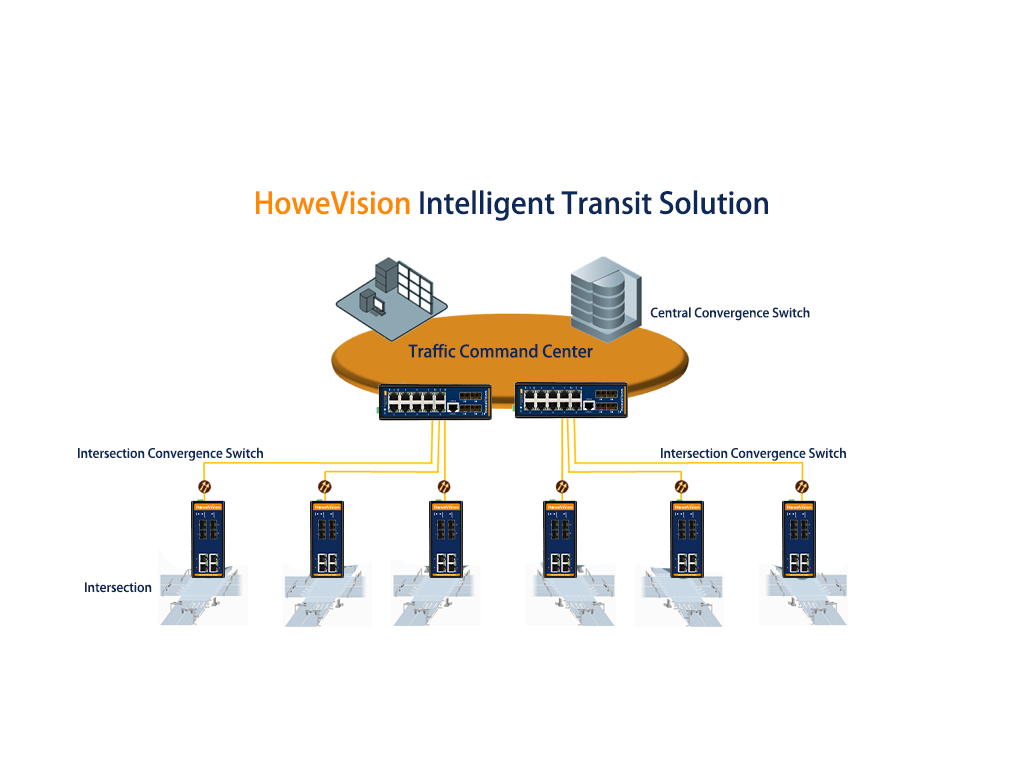
Advantages and Disadvantages of Star Topology.
Advantages:
High bandwidth, robust network, easy to plan. Each junction enjoys its transmission link with higher transmission bandwidth, and the link failure between different corners does not affect each other, enhancing network robustness. Independent transmission bandwidth and link resources do planning and design simple and convenient.
Disadvantages:
consume many fiber resources, high cost, and lack of protection mechanism. Each intersection requires a separate fiber optic cable, which takes up more fiber resources and increased construction costs—lack of link protection mechanism for individual intersections.
Application scenarios:
Where fiber resources are sufficient, and no protection is needed for individual intersections—for example, the case of leasing bare fiber from telecom operators, usually using star-shaped networking.
Networking mode 2: Ring Topology
Ring topology in which switches are connected two by two, forming a closed-loop circuit. It is the most common topology for hierarchical transmission networks.
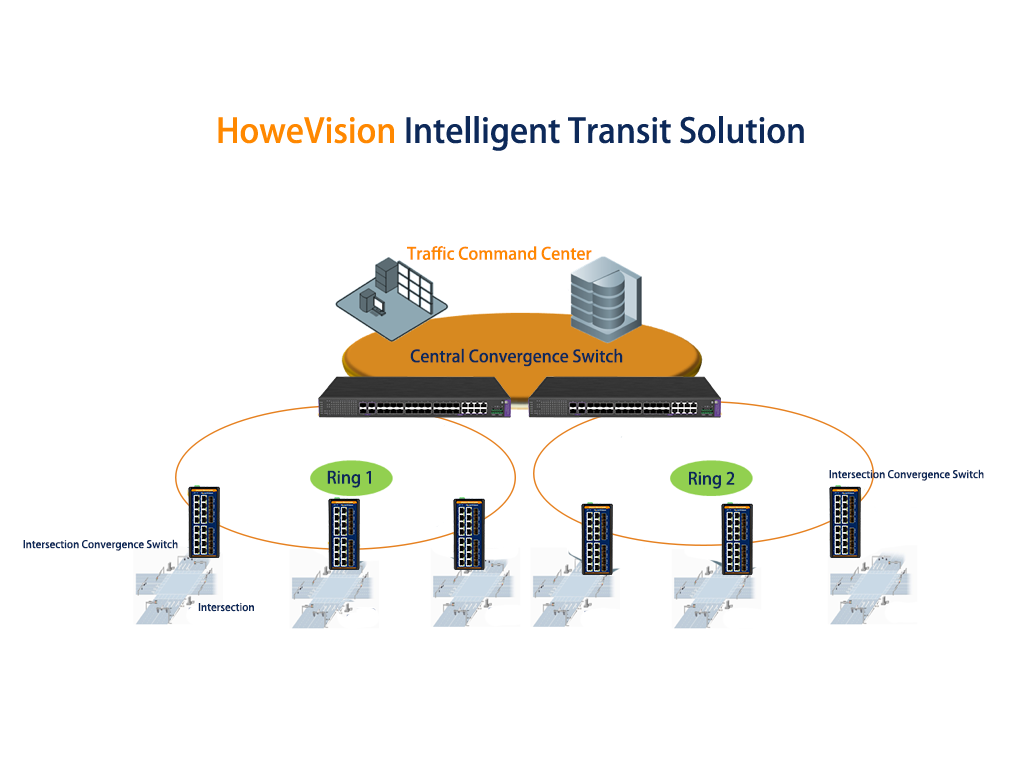
Advantages and Disadvantages of Ring Topology.
Advantages:
They are saving fiber resources and link protection mechanisms. Different access points share the same transmission channel, maximizing the utilization of fiber links and significantly saving fiber resources. Any two issues have two communication paths. The topology has the ability of redundancy protection; redundant ring network protocol can realize the network self-healing within 20ms in case of link failure.
Disadvantages:
Complex planning and design. The scheme design needs to fully consider the transmission bandwidth demand (including pre-construction and later expansion demand), determine the total transmission bandwidth of the ring network, and plan the routing according to the point distribution.
Application scenarios:
scenarios with limited fiber resources or requiring link redundancy protection, requiring fiber resources with closed-loop conditions. For example, self-built fiber optic cable.
Networking Mode 3: Intersecting Ring Topology
A more special class of crossing rings in the ring topology can achieve more comprehensive protection. The reasons for using phase intersecting ring networking are as follows.
- Outfield equipment points are more widely distributed, the return fiber optic cable is scarce and limited, needs convergence in the outfield, and provides a higher convergence ratio.
- More equipment points in the field, using star networking to occupy many fiber resources, so the ring network solution.
- The convergence and return equipment carry many services; if the equipment failure will cause severe consequences to the network, the returned equipment (the convergence and return switch in the figure) double parallel transmission, mutual backup, and achieve load balancing.
The traditional spanning tree protocol has a small convergence radius and long reversal time for this large and complex network, making it challenging to meet the project requirements. The managed industrial switch supports ITU-T G.8032 protocol. The intersecting ring can make full use of line resources, provide comprehensive protection, and provide reliable network transmission for the whole network.
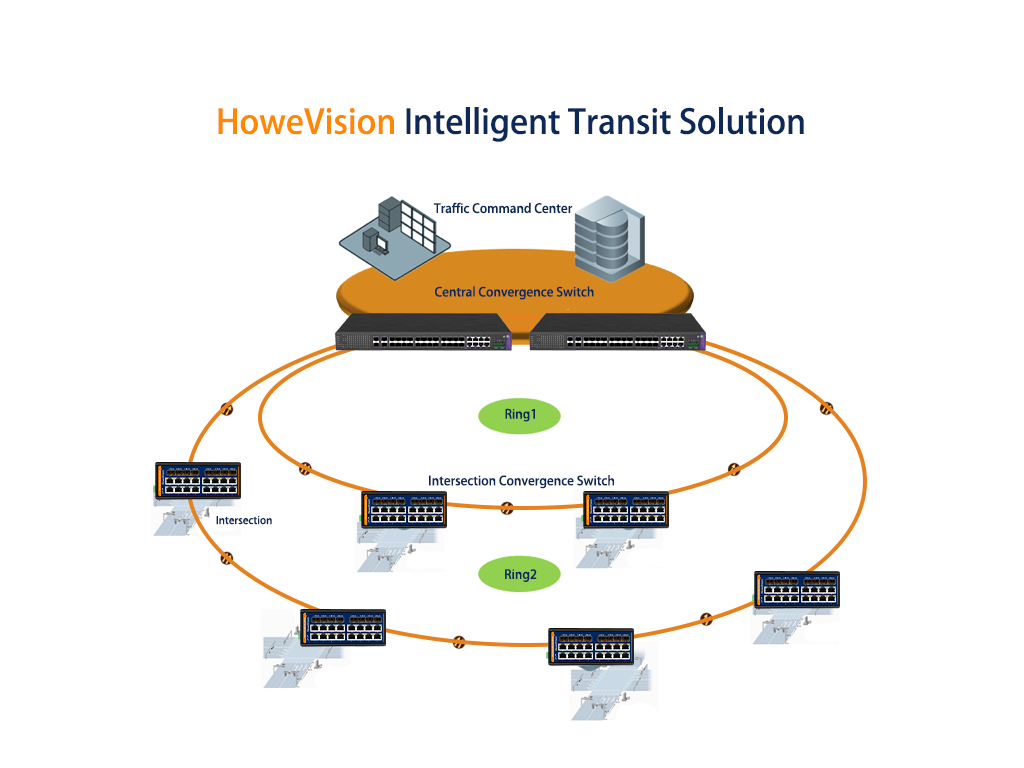
Application scenarios: Large networks with many access junctions and high protection requirements.
Access Layer Network Solution
Intelligent transportation system front-end information collection is mainly distributed in various intersections and essential city areas. The front-end device interface in multiple forms, transmission needs, complex installation environment corresponding to different needs, and network access is also flexible and diverse ways of implementation.
Front-end service access mainly has the following options, according to the different business characteristics and environmental requirements, you can choose one of them or mixed back transmission.
Traditional Junction Access Scheme (transceiver point-to-point backhaul)
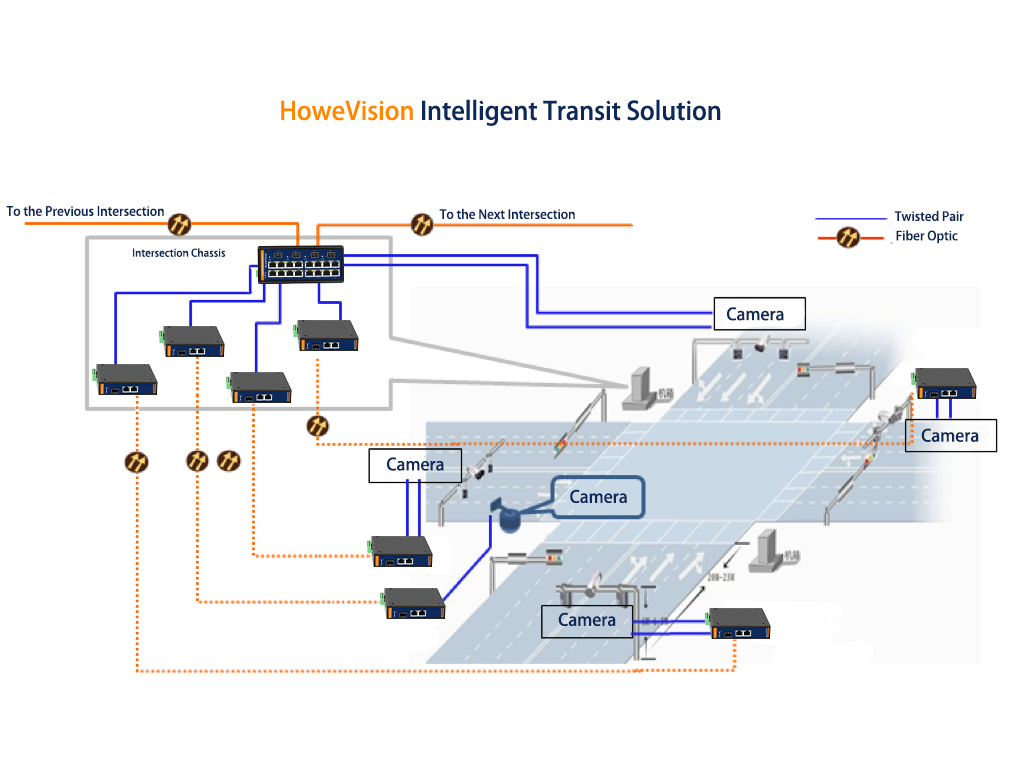
The traditional intersection access scheme uses non-network-managed transceiver transmitter and receiver pairs to pass the service back to the intersection switch.
Solution disadvantages.
- More faulty nodes.
- Complex construction wiring and fault maintenance.
- High power consumption of the intersection equipment.
- No management functions for transceivers.
Advantages.
- Simple design and straightforward interface.
Optimized Intersection Access Scheme (intersection optical convergence)
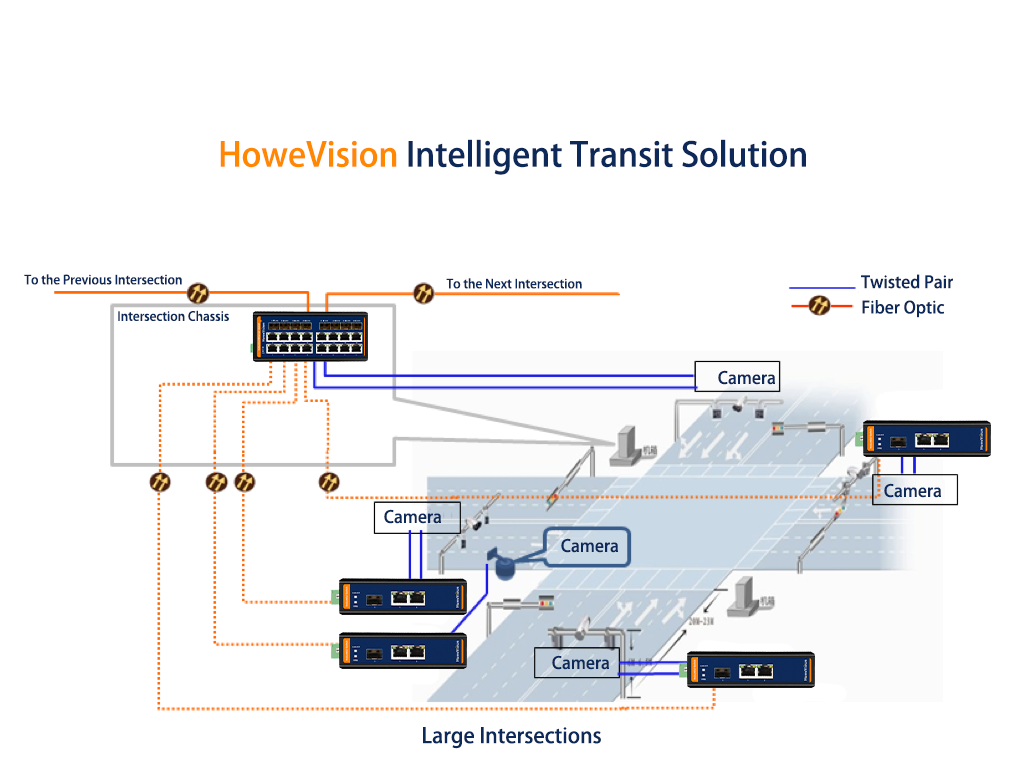
Using a managed transceiver transmitter and intersection switch, the optical port of the transceiver is directly connected to the optical port of the switch, which can unify the return of various services that need to be accessed at the intersection. One visual and two electrical managed transceivers support management functions, support port VLAN, etc., which can meet the video return needs of one of the directions of an intersection. It is possible to transmit the services through or isolate different services through the VLAN of the ports so that the services are not affected by each other.
Program advantages
- Reduction of fault nodes.
- Simplification of engineering wiring and acceleration of project progress.
- We are reducing the power consumption of intersection equipment.
- Port VLAN to achieve multi-service isolation.
- Remote management of front-end transceivers, such as equipment monitoring, configuration management, alarm management, etc.
Electric Police Access Optimization Scheme (multi-service multiplexing)
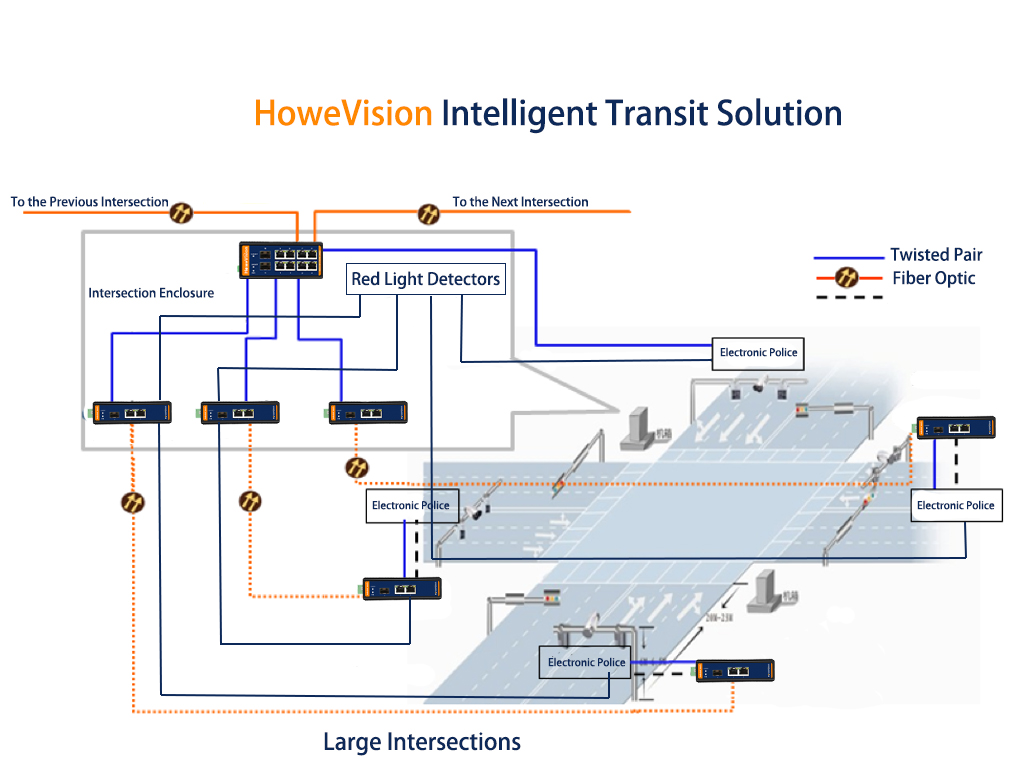
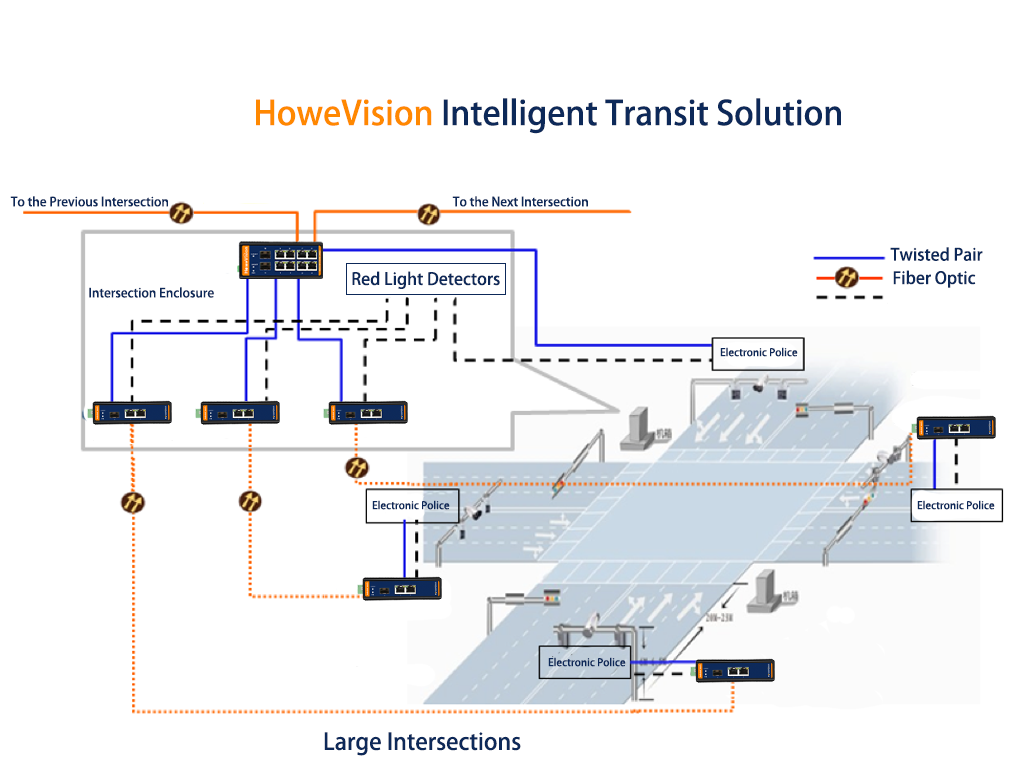
The traditional solution is to lay fiber-optic at the intersection while also laying RS232/RS485 lines (connecting the red light detector to the electric police camera), increasing construction difficulty and cost. The optimized solution uses a managed transceiver with a serial port to replace the original common type transceiver; the video service is accessed through the Ethernet port, and the red light detection signal is accessed through the serial port. The transceiver multiplexes the two services into one fiber optic link for transmission, eliminating the need to lay RS232/RS485 lines, simplicity, and efficiency, saving project materials and construction costs.
Solution advantages
- Multi-service multiplexing, saving construction costs.
- Simplification of engineering wiring and acceleration of project progress.
- Remote management of front-end transceivers, such as equipment monitoring, configuration management, alarm management, etc.
Wireless Access Scheme (3 G/4G access)
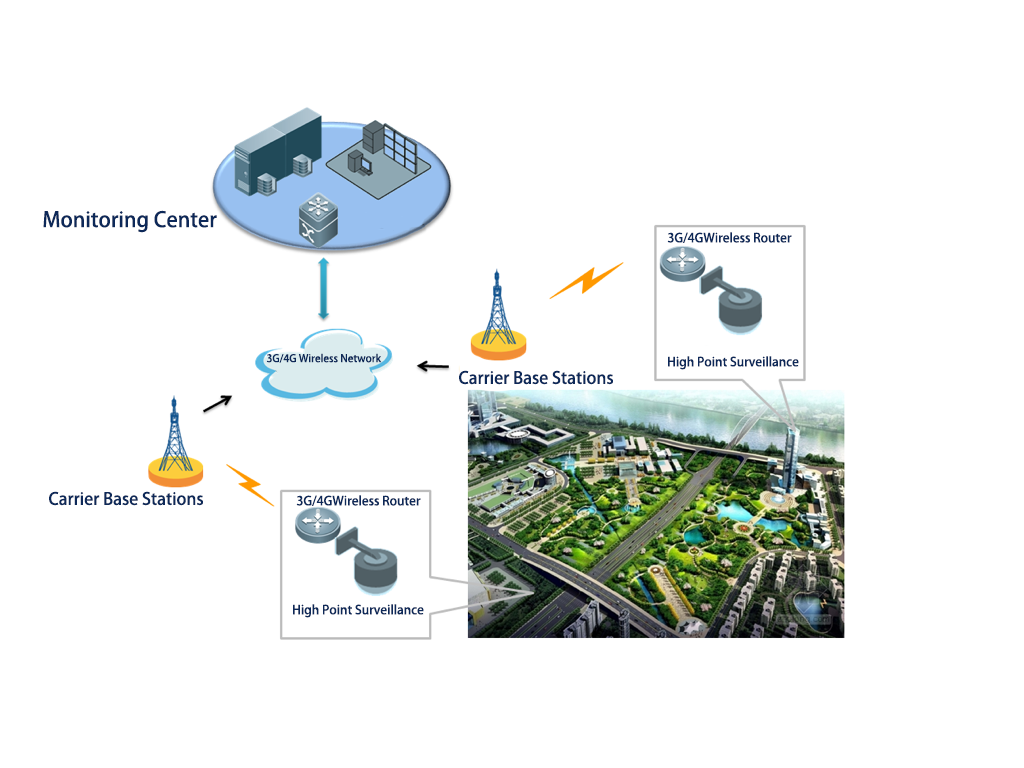
Some intersections or public areas do not have wired communication conditions, or wiring costs are high; you can use the 3G/4G wireless router to achieve service back transmission. 3G/4G high-speed wireless network as a data-bearing network provides a safe high-speed wireless connection for networking between remote devices and sites.
Solution advantages:
- High-speed rate bandwidth to meet real-time video backhaul.
- Support connection detection mechanism to ensure that the network is always online.
- With VPN function, supporting device data transmission in secure IPSec tunnel.
- Multiple encryption methods support AES and TKIP encryption; support 64-bit and 128-bit WEP encryption; the key can be HEX or ASCII character input.
Network Management and Maintenance
Network Management
Support multiple management methods for configuration and management, including SNMP, Web, CLI, and other methods.
SNMP Management
SNMP (Simple Network Management Protocol) is a set of network management protocols proposed by IETF (Internet Engineering Task Force) to solve the management problems of network devices on the Internet. SNMP is a network management protocol proposed by the IETF (Internet Engineering Task Force) to address the management of network devices on the Internet. SNMP enables a network management system to remotely manage all network devices that support this protocol, including monitoring network status, modifying network device configuration, and receiving network event alarms. It is the most widely used network management protocol in TCP/IP networks, and the structure of SNMP is divided into two parts: Agent and NMS. The agent and NMS communicate with each other by transmitting SNMP messages through UDP. The NMS system independently developed by HoweVision Technology is based on SNMP protocol and oriented to the access network, focusing on solving the problems of centralized configuration and fault detection of the whole series of manageable network devices of HoweVision Technology.
Web Management
By logging into the Web network management client, the equipment of HoweVision Technology provides easy and convenient graphical management. Under the graphical interface, the operation menu is on the left, and the display window is on the right. The Web client interface is straightforward, and users can intuitively maintain and configure the equipment.
CLI (command-line interface) Command-Line Interface
In the interface where users type in executable commands at the prompt, users can usually use the quick command window of the windows operating system. If you know the IP address and the network, you can use telnet to log in to the device locally or remotely.
HoweVision Technology network management series products are equipped with a console port, the console access port of the device. The user can make initial configuration and subsequent management of the device through the terminal (or simulation terminal). CLI management is for professionals familiar with network products and knowledge of data communication.
Network Maintenance
HoweVision Technology industrial switch provides rich and comprehensive management functions. In addition to the necessary tasks for network construction, it also offers many functions for network maintenance, thus improving the convenience of network maintenance and bringing comfort to construction and maintenance personnel.
Optical Module Digital Diagnosis
The optical module digital diagnosis function can be an essential auxiliary tool for network maintenance. By reading the monitoring data of temperature, voltage, and optical power, network administrators can analyze the operational status of the module. For example, it can determine whether the module is operating normally and whether the received optical power meets the standard to diagnose network failure and rapidly reduce operation and maintenance costs. Digital diagnosis supports parameter threshold setting, and when the performance parameters reach the alarm threshold or the status information changes, the corresponding Trap alarm message will be generated.
Port Mirroring:
In-network fault location analysis, We use the port mirroring function to monitor the real-time data of switch ports. The port reflecting position mirrors all messages from the specified source port to the destination port (monitoring port) but does not affect normal message forwarding. You can monitor the messages received and sent on the switch ports and analyze the related network conditions using this function.
Port Statistics:
Sometimes, network adjustments are made based on the actual port traffic size during project implementation. The port statistics function can view the port traffic status and obtain data traffic information for network adjustments (such as link aggregation and port rate change). In addition, the port statistics function supports packet type statistics, wrong packet statistics, packet loss statistics, etc., which can assist in locating network faults.
Intelligent Transportation Key Products Recommendation
10 Gigabit Layer 3 Core Ethernet Switches

- Key Feature:
- Cache up to 12Mbit can meet the smooth transmission of 4K video
- Support IEEE802.3/802.3u/802.3ab/802.3z/802.3x store-and-forward mode
- Supports large backplane bandwidth and large switch cache to ensure wire-speed forwarding of all ports
- Support ITU G.8032 standard ERPS ring network protocol, self-healing time less than 20ms
- Support the international standard IEEE 802.3D/W/S standard STP/RSTP/MSTP protocol
- Support static routing, RIPv1/v2, OSPFv2
- Redundant dual power supply DC/AC power specifications optional, anti-reverse connection, over-current protection function
- -40℃~85℃ wide temperature design, ensure the equipment adapts to the various harsh field environment
Industrial 14-Ports Gigabit Managed Ethernet PoE Switch
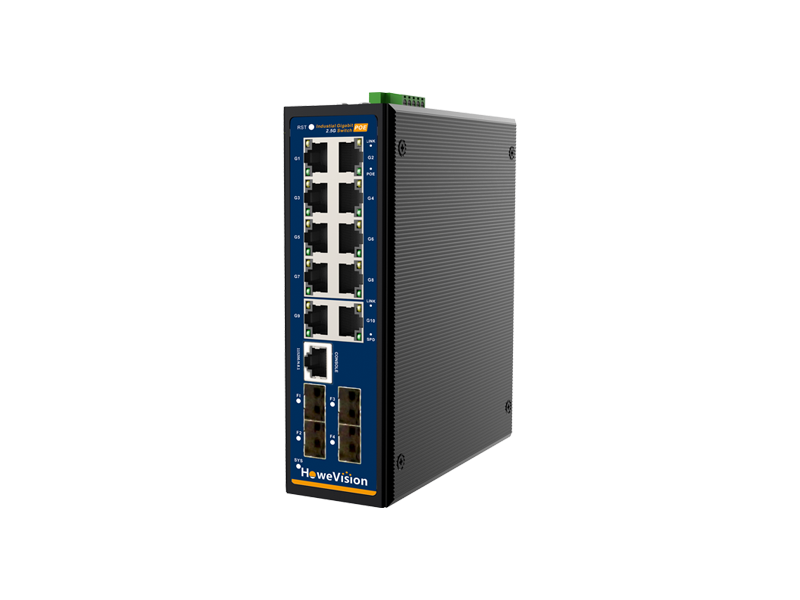
- Model: IPS50824GFM
- L2+ Managed industrial Gigabit Ethernet PoE switch,
- Support 802.1Q VLAN, Mirroring, Port isolation, IGMP, DHCP, LLDP, DDM, POE+ management
- Support spanning tree STP(802.1D) and RSTP(802.1W). MSTP(802.1S).
- Support management through WEB, CLI, TELNET, SSH, SNMP(V1, V2, V3)
- 5 years warranty.
- OEM/ODM is available
- Small MOQ is welcome
Industrial Gigabit Ethernet PoE Switch, 4 Ports PoE+, 2 Ports SFP Uplink
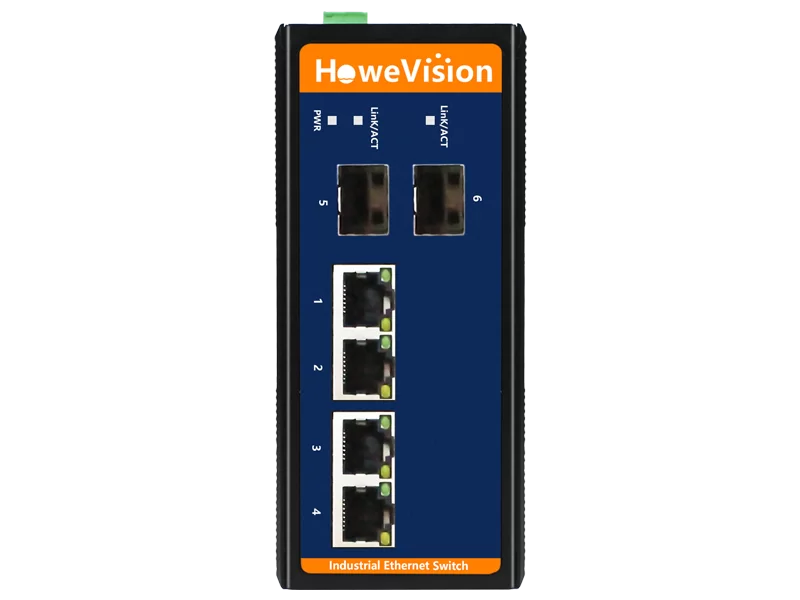
- Model: IPS4G2GF
- Unmanaged Industrial Gigabit Ethernet Switch PoE
- 9-56V DC redundant power with polarity reverse protect
- -40 to 75 degrees C operating temperature
- IP40 aluminum case without Fan
- 5 years warranty.
- OEM/ODM is available
- Small MOQ is welcome
Successful cases of intelligent transportation HoweVision
- Beijing Public Security Traffic Administration Signal Control System (Phase III)
- Beijing Mobile Changping Road Bureau Road Monitoring Project
- Tianjin Eco-city Bus Intelligent Project
- Tianjin Eco-city Intelligent Transportation System Phase II
- Intelligent Traffic System of Two Horizontal and Three Vertical Expressways in Changchun City, Jilin Province
- Inner Mongolia Hulunbeier City Intelligent Transportation System
- Inner Mongolia Bayannur City Wuyuan Public Security Bureau Intelligent Transportation Project
- Inner Mongolia Erdos City Public Security Bureau Traffic Management Detachment Intelligent Traffic Management System
- Inner Mongolia Hohhot City Expressway Traffic Engineering Section 1
- Yantai City, Shandong Province long-distance bus entertainment Internet system
- Intelligent Traffic Management System of West Coast New Area, Qingdao City, Shandong Province
- Shandong Province Qingdao City Public Security Bureau video surveillance illegal automatic capture system
- Smart Traffic Management Service System Phase II in Weihai City, Shandong Province
- The intelligent bus system in Weihai City, Shandong Province
- Jinan City, Shandong Province Tunnel Monitoring System Phase II
- Smart Transportation Project in Zibo City, Shandong Province
- Shanxi University City Intelligent Transportation Project
- 320″ Project in Suzhou Industrial Park, Jiangsu Province
- Nanjing City, Jiangsu Province, the west main road tunnel electromechanical system
- Smart Driving School Training System in Suzhou, Jiangsu Province
- Suqian Industrial Park Intelligent Transportation Project in Jiangsu Province
- Wuxi City, Jiangsu Province, Intelligent Transportation Project
- Ningbo Public Bike Rental Project, Zhejiang Province
- Zhejiang Province Jinhua BRT Line 2 Intelligent Control System
- Hubei Yichang Public Security Bureau Intelligent Transportation System Upgrade Project
- Operation of three major systems in the sub-project of the BRT system project in Dongshan Avenue, Yichang City, Hubei Province
- Traffic Engineering and Public Security Monitoring for the Sub-Project of BRT System Engineering on Dongshan Avenue in Yichang City, Hubei Province
- Chenzhou City, Hunan Province Intelligent Transportation Project
- Loudi City, Hunan Province Intelligent Transportation Project
- Yiyang City, Hunan Province Intelligent Transportation Project
- Hengshui City, Hebei Province, Intelligent Transportation Project
- Video monitoring system for the industrial park of Qingxian farm in Cangzhou City, Hebei Province
- Monitoring System of G108 National Highway (Hebei Section) Renovation Demonstration Project in Baoding, Hebei Province
- Video Surveillance System Project in Xingtai Nanhe County, Hebei Province
- Ningxia Yinchuan Yingu Expressway Toll Collection System
- Ningxia Jingzang Expressway, Dingwu Expressway monitoring system renovation project
- Ningxia Yinchuan Jinfeng District Intelligent Transportation Project
- Lanzhou, Gansu Province – Digital Lanzhou “Telematics” Intelligent Transportation Project
- Anshun City, Guizhou Province, Ziyun Miao-Buyi Autonomous County Public Security Bureau Intelligent Transportation Project
- Zhanjiang City, Guangdong Province Traffic Police Intelligent Command Center Information Construction Project


